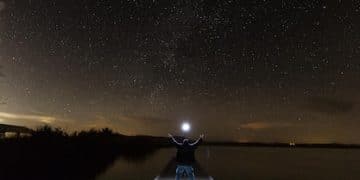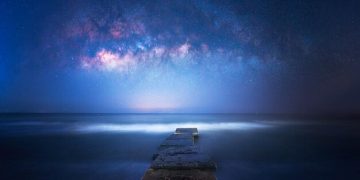Meteor showers with best observation dates to mark on your calendar
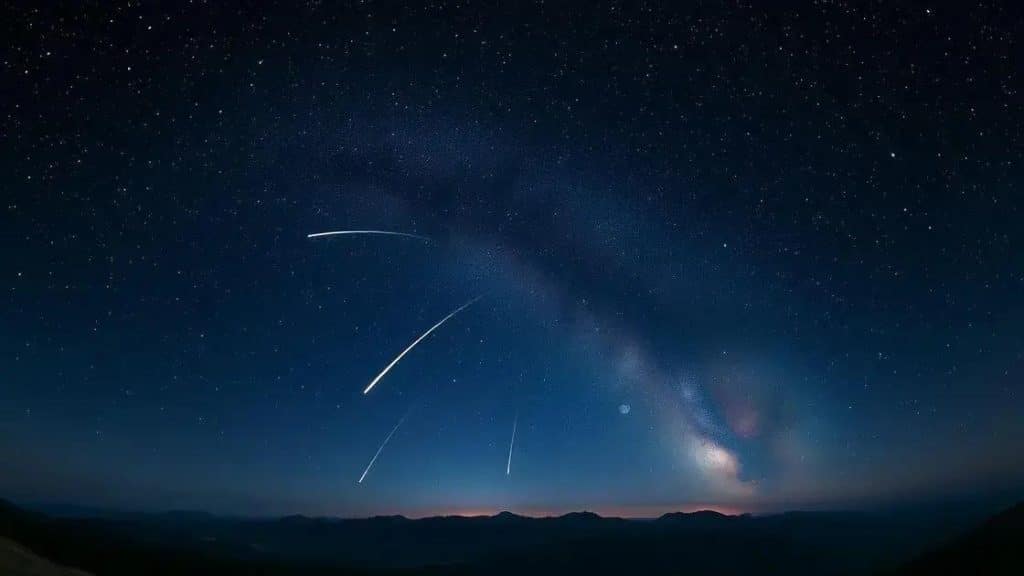
Meteor showers are spectacular celestial events where meteors illuminate the night sky, best observed in dark locations during peak times after midnight.
Meteor showers with best observation dates can turn a regular night into an extraordinary experience. Curious about when these celestial displays happen? Keep reading to plan your stellar adventure!
Understanding meteor showers
Understanding meteor showers is essential for anyone interested in astronomy. These natural events occur when meteoroids enter Earth’s atmosphere and ignite, creating bright streaks in the sky. Knowing what makes these phenomena unique can enhance your experience when watching them.
What Are Meteor Showers?
Meteor showers happen at specific times of the year when Earth passes through the debris left by comets. Each meteor shower features meteors from a specific comet, making them fascinating to observe. During a meteor shower, the rate of meteors can vary significantly. Some nights, you may see just a few meteors, while others may showcase dozens or even hundreds!
Types of Meteor Showers
There are several major meteor showers observed annually, which are tied to specific comets. Here are a few notable ones:
- Perseid Meteor Shower: Occurs every August, peaking around the 12th and 13th.
- Geminid Meteor Shower: Happens in December, known for its bright and colorful meteors.
- Quadrantid Meteor Shower: Peaks early January and is quite prominent but short-lived.
Watch for these meteor showers in your area, as the best viewing conditions often occur away from city lights. The key is to find a dark spot and lie back comfortably. As you watch, take a moment to savor the beauty of the night sky.
Understanding the timing of these events can also add to your excitement. For instance, the Perseid Meteor Shower is famous for its high activity level. Planning your viewing around these peak times can reward you with an unforgettable experience.
To prepare for a night of meteor watching, check the moon’s phase and local weather conditions. A clear, moonless night provides the best visibility for catching those fleeting meteors.
Best meteor showers to observe
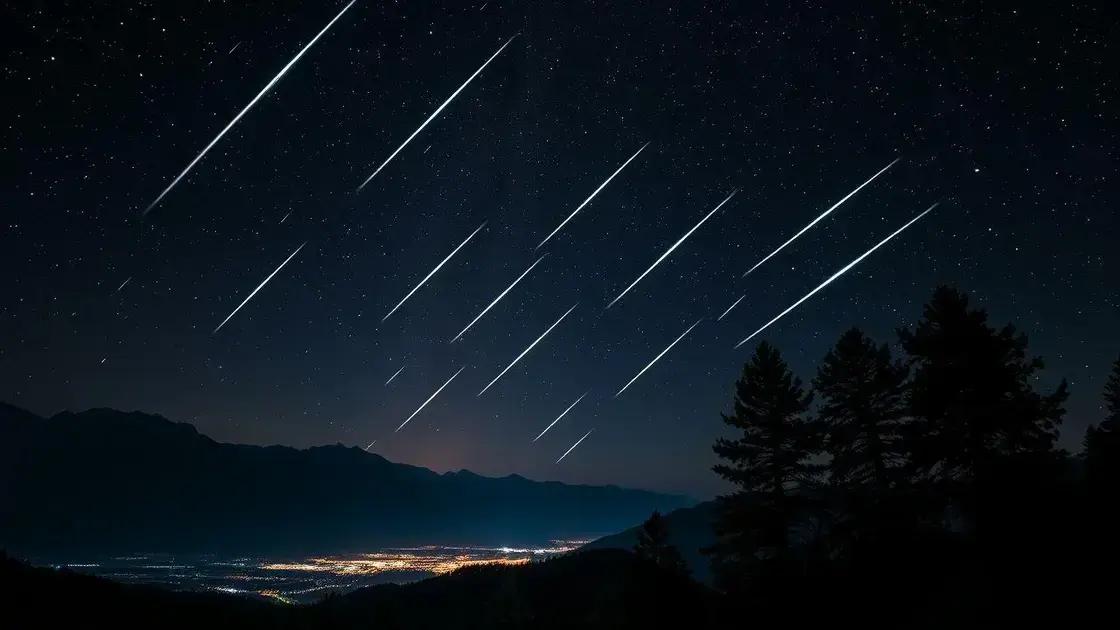
When it comes to the best meteor showers to observe, knowing the key events can enhance your stargazing experience. Each year, several meteor showers are easily visible, offering stunning displays for anyone willing to look up.
Top Meteor Showers to Catch
Here are some of the most popular meteor showers that every sky watcher should consider:
- Perseid Meteor Shower: This annual shower peaks around August 12th, offering up to 60 meteors per hour in ideal conditions.
- Geminid Meteor Shower: Occurring in December, the Geminids are known for their vibrant colors and can produce over 100 meteors per hour.
- Quadrantid Meteor Shower: Peaking in early January, this shower can be intense but lasts only a short time, making it a unique event to catch.
Observing these showers can be breathtaking. Imagine lying under a clear, dark sky as meteors streak across your field of vision! It’s essential to plan ahead, so you catch these celestial performances at their peak.
Optimal Conditions for Viewing
To fully enjoy the best meteor showers, here are some tips to improve your viewing experience:
- Find a dark location away from city lights.
- Consider the moon phase; a new moon is ideal for better visibility.
- Give your eyes time to adjust to the darkness.
With these meteor showers, timing is often everything. For example, the Perseid shower is best viewed around midnight and into the early morning hours, when the sky is darkest. The excitement builds as you wait for those bright streaks of light!
Ultimately, knowing the dates and characteristics of these celestial events can turn your ordinary night into an extraordinary adventure. Watching a meteor shower is not just about seeing meteors; it’s about experiencing the wonder of the universe and its mysteries.
Tips for optimal meteor shower viewing
To enjoy the best experience during meteor showers, consider these tips for optimal meteor shower viewing. A little preparation can make your stargazing outing much more enjoyable.
Choose the Right Location
Your viewing spot matters! Try to find a place that is far from city lights. Good locations include parks or open fields. Being away from light pollution allows you to see more meteors.
Timing is Key
Meteor showers have peak times, usually around midnight or in the early morning hours. For instance, the Perseid meteor shower is best viewed after midnight. Make sure to check the specific dates and times for the shower you plan to observe.
Get Comfortable
Bring along a comfortable chair or blanket. It’s important to lie back and relax as you watch the sky. Don’t forget to dress for the weather! Warm clothes can help you stay cozy while you wait for meteors.
- Be Patient: Meteor watching requires patience. You may need to wait a little while before seeing a meteor.
- Allow Your Eyes to Adjust: Give your eyes about 20 minutes to adjust to the darkness. This will help you spot meteors more easily.
- Keep the Moon in Mind: A bright moon can wash out fainter meteors. Ideally, try to plan your viewing when the moon is new or in a waning phase.
During the shower, keep your binoculars and cameras aside. They might distract you. Instead, focus on the vastness of the night sky. It’s a magical experience to just watch the stars and catch a glimpse of a shooting star.
Sharing the experience with friends or family can also enhance your enjoyment. Make it a fun night out, complete with snacks and drinks, as you await those spectacular meteors!
Safety during meteor shower events
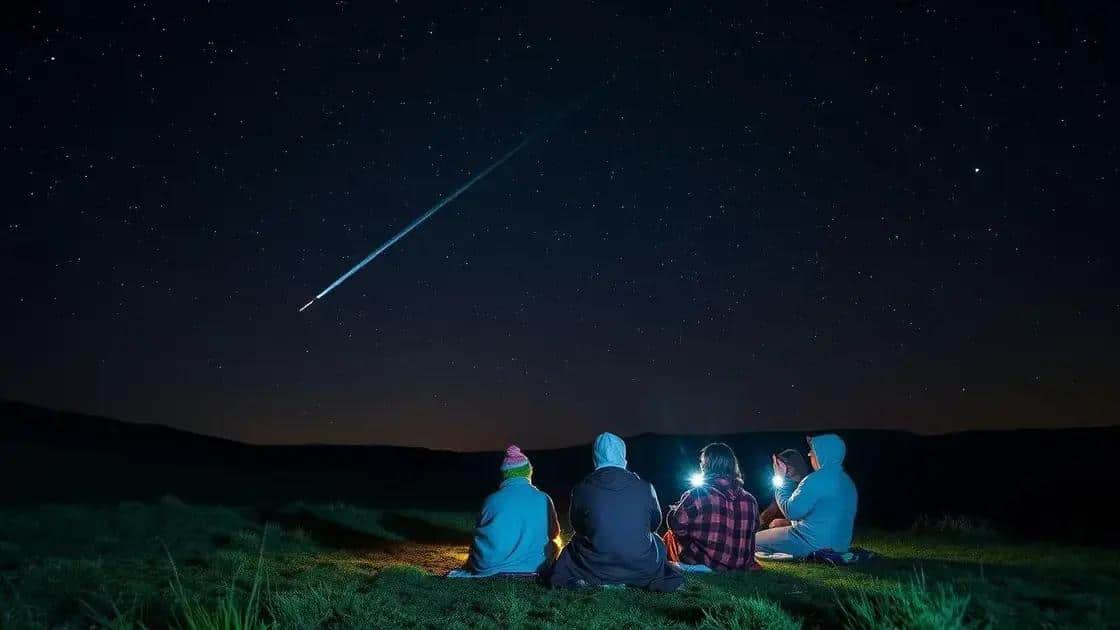
While enjoying meteor showers can be thrilling, ensuring safety during meteor shower events is essential for a fun experience. Observing the night sky can come with its own set of challenges, so it’s important to be prepared.
Choose a Safe Location
Select a spot that is safe and accessible. Avoid areas that are isolated or far away from help in case of an emergency. Parks, open fields, or designated viewing areas are often good choices. Make sure the ground is stable and free from hazards like thorny bushes or uneven terrain.
Be Aware of Wildlife
Depending on where you decide to watch the meteor shower, be aware of the local wildlife. This can include everything from insects to larger animals. Bring insect repellent to keep bugs away. If you might be in a location where there could be wildlife, it’s a good idea to have a friend with you.
Stay Hydrated
Prepare for the event by packing water and snacks. Staying hydrated is crucial, especially if you plan to be outside for several hours. Water can also help keep you alert and comfortable as you wait for the meteor activity to peak.
- Bring a flashlight: A low-light flashlight can help you navigate without ruining your night vision.
- Dress appropriately: Check the weather forecast and wear layered clothing suitable for the temperature.
- Know your limits: If you start to feel uncomfortable or tired, it’s okay to pack up and go home early.
In addition to these tips, it’s wise to inform someone about your plans. Let them know where you are going and when you expect to return. This way, someone will know to look for you if you don’t come back as expected.
By taking these precautions, you can focus on enjoying the beauty of the night sky while staying safe and comfortable. Watching the meteors should be a joyful moment, so being prepared will make it even better!
FAQ – Frequently Asked Questions about Meteor Showers
What is a meteor shower?
A meteor shower occurs when Earth passes through the debris left by comets, resulting in bright streaks of light in the night sky.
When is the best time to observe meteor showers?
The best time to observe meteor showers is typically after midnight into the early morning hours when the sky is darkest.
How can I prepare for a meteor shower viewing?
Prepare by choosing a dark location, bringing snacks and drinks, and allowing your eyes to adjust to the darkness for better visibility.
Is it safe to watch meteor showers outdoors?
Yes, but ensure you choose a safe location, be aware of wildlife, stay hydrated, and inform someone of your plans.
